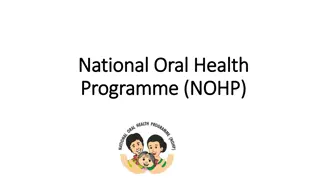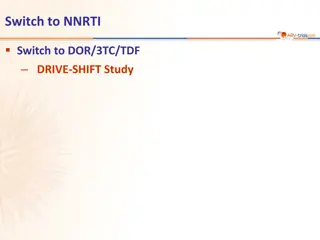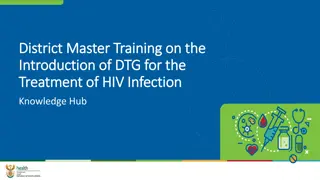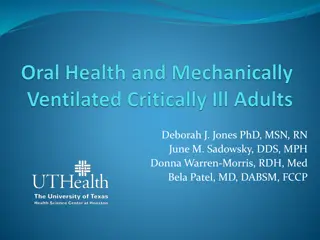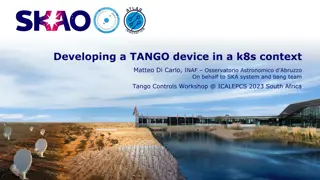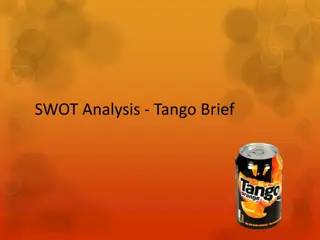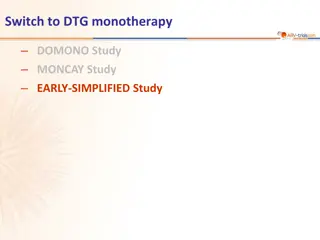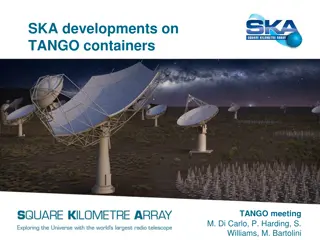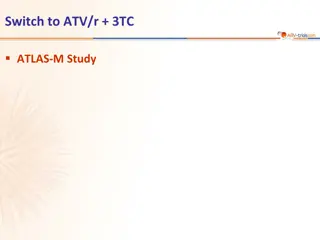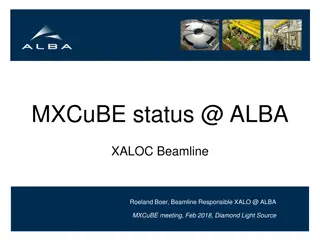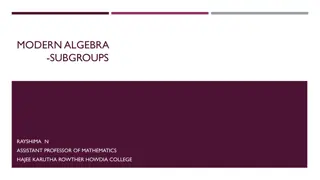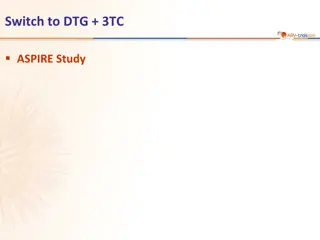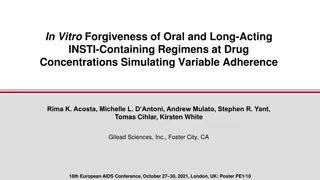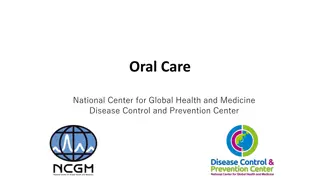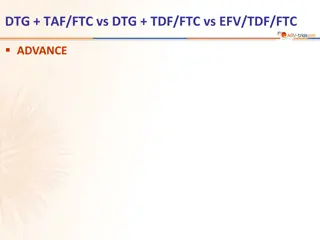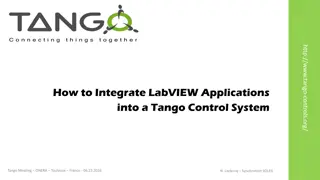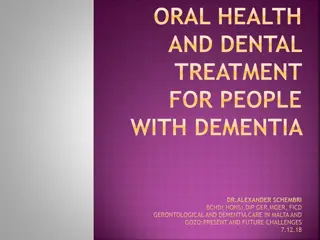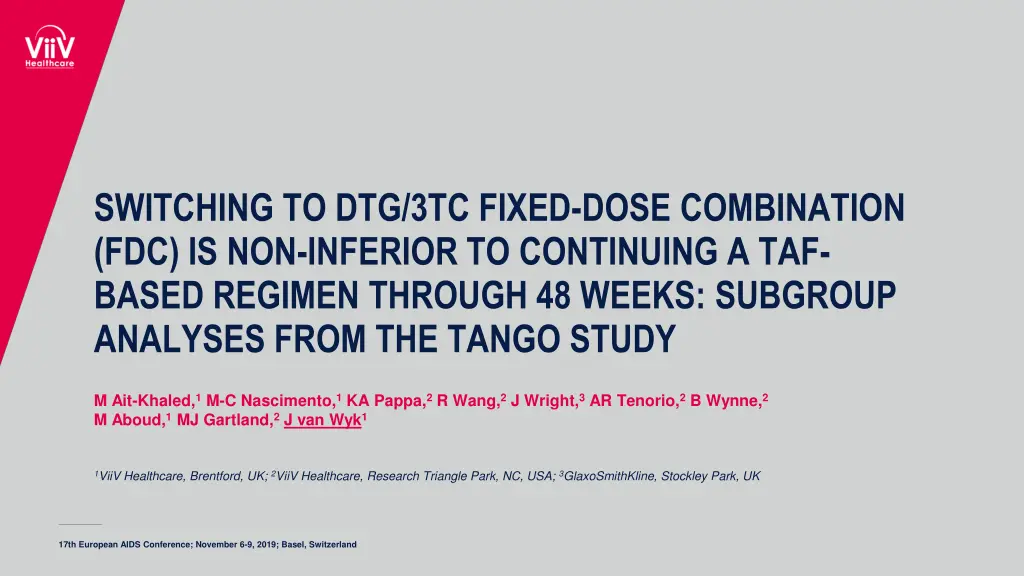
Non-Inferiority of Switching to DTG/3TC FDC in HIV-1 Infected Adults
Explore subgroup analyses from the TANGO study showing that switching to DTG/3TC Fixed-Dose Combination (FDC) is non-inferior to continuing a TAF-based regimen through 48 weeks. The study evaluates virologic success, demographics, and disease characteristics, supporting the use of a two-drug regimen for PLWHIV.
Download Presentation

Please find below an Image/Link to download the presentation.
The content on the website is provided AS IS for your information and personal use only. It may not be sold, licensed, or shared on other websites without obtaining consent from the author. If you encounter any issues during the download, it is possible that the publisher has removed the file from their server.
You are allowed to download the files provided on this website for personal or commercial use, subject to the condition that they are used lawfully. All files are the property of their respective owners.
The content on the website is provided AS IS for your information and personal use only. It may not be sold, licensed, or shared on other websites without obtaining consent from the author.
E N D
Presentation Transcript
SWITCHING TO DTG/3TC FIXED-DOSE COMBINATION (FDC) IS NON-INFERIOR TO CONTINUING A TAF- BASED REGIMEN THROUGH 48 WEEKS: SUBGROUP ANALYSES FROM THE TANGO STUDY M Ait-Khaled,1M-C Nascimento,1KA Pappa,2R Wang,2J Wright,3AR Tenorio,2B Wynne,2 M Aboud,1MJ Gartland,2J van Wyk1 1ViiV Healthcare, Brentford, UK; 2ViiV Healthcare, Research Triangle Park, NC, USA; 3GlaxoSmithKline, Stockley Park, UK 17th European AIDS Conference; November 6-9, 2019; Basel, Switzerland
Disclosures Jean van Wyk is an employee of ViiV Healthcare 17th European AIDS Conference; November 6-9, 2019; Basel, Switzerland Ait-Khaled et al. EACS 2019; Basel, Switzerland. Slides PS7/2. 2
Background Two-drug regimens (2DRs) reduce the number of drugs for PLWHIV who need lifelong ART1 In the GEMINI-1 and GEMINI-2 studies, DTG + 3TC was non-inferior to DTG + TDF/FTC in HIV-1 infected treatment-naive adults at Week 482 and Week 963 The results led to the marketing authorization of DTG/3TC fixed-dose combination (FDC; DOVATO) as a once-daily, single-tablet 2DR by the US Food and Drug Administration and the European Medicines Agency TANGO is an ongoing phase III, non-inferiority trial evaluating efficacy and safety of a switch to DTG/3TC FDC in HIV-1 infected adults with virologic suppression on a 3- or 4-drug TAF-based regimen Here we present a key secondary endpoint from the TANGO study: Snapshot virologic success by baseline third agent class, demographics, and disease characteristics at Week 48 1. Kelly et al. Drugs. 2016;76:523-531. 2. Cahn et al. Lancet. 2019;393:143-155. 3. Cahn et al. IAS 2019; Mexico City, Mexico. Slides WEAB0404LB. 17th European AIDS Conference; November 6-9, 2019; Basel, Switzerland Ait-Khaled et al. EACS 2019; Basel, Switzerland. Slides PS7/2. 3
TANGO Phase III Study Design Randomized, open-label, multicenter, parallel-group, non-inferiority study Screening Randomizationa 1:1 Early-switch phase Late-switch phase Continuation phase DTG/3TC DTG/3TC (N=369)b Adults, virologically suppressed (HIV-1 RNA <50 c/mL) for >6 months Stable TAF-based regimen DTG/3TC DTG/3TC TAF-based regimen (N=372) Day 1 Week 24 Week 48 Week 96 Week 144 Week 148 Week 196 Eligibility criteria 2 documented HIV-1 RNA measurements <50 c/mL No HBV infection or need for HCV therapy No prior VF and no documented NRTI or INSTI resistance TAF/FTC + PI or INSTI or NNRTI as initial regimenc Countries Primary endpointd: participants with virologic failure per FDA Snapshot (ITT-E)e Australia Belgium Canada France Germany Japan Netherlands Spain United Kingdom United States aStratified by baseline third agent class (PI, INSTI, or NNRTI). bTwo patients excluded who were randomized but not exposed to study drug. cParticipants with initial TDF treatment who switched to TAF 3 months before screening, with no changes to other drugs in their regimen, were also eligible. d4% non-inferiority margin. eIncludes participants who changed a background therapy component or discontinued study treatment for lack of efficacy before Week 48, or who had HIV-1 RNA 50 c/mL in the 48-week window. 17th European AIDS Conference; November 6-9, 2019; Basel, Switzerland Ait-Khaled et al. EACS 2019; Basel, Switzerland. Slides PS7/2. 4
Demographics: ITT-E Population DTG/3TC (N=369) 40 (20-74) 79 (21) 25 (7) TAF-based regimen (N=372) 39 (18-73) 92 (25) 33 (9) Characteristic, n (%) Age, median (range), y 50 y Female Race Black or African American Asian White Other Ethnicity Hispanic or Latino Not Hispanic or Latino 50 (14) 13 (4) 297 (80) 9 (2) 58 (16) 13 (3) 289 (78) 12 (3) 69 (19) 300 (81) 66 (18) 306 (82) 17th European AIDS Conference; November 6-9, 2019; Basel, Switzerland Ait-Khaled et al. EACS 2019; Basel, Switzerland. Slides PS7/2. 5
Baseline Characteristics: ITT-E Population DTG/3TC (N=369) 682 (133-1904) TAF-based regimen (N=372) 720 (119-1810) Characteristic, n (%) Median CD4+ cell count (range), cells/mm3 CD4+ cell count, cells/mm3 <350 35 (9) 334 (91) 30 (8) 342 (92) 350 Baseline third agent class INSTI EVG/c NNRTI RPV PI bDRV Duration of ART before Day 1, median (range), mo 289 (78) 243 (66) 51 (14) 43 (12) 29 (8) 25 (7) 33.8 (7.1-201.2) 296 (80) 249 (67) 48(13) 45 (12) 28 (8) 27 (7) 35.1 (7.0-160.8) 17th European AIDS Conference; November 6-9, 2019; Basel, Switzerland Ait-Khaled et al. EACS 2019; Basel, Switzerland. Slides PS7/2. 6
DTG/3TC Is Non-inferior to TAF-Based Regimen at Week 48 Adjusted treatment difference (95% CI)b 100 DTG/3TC (N=369) 93.2 93.0 TAF-based regimen DTG/3TC 80 participants, % Proportion of TAF-based regimen (N=372) 60 4% non- inferiority margin 0.7 -1.2 40 -0.3 20 6.5 6.5 0.5 0.3 0 -8 -6 -4 -2 Difference, % 0 2 4 6 8 HIV-1 RNA <50 c/mL No virologic data HIV-1 RNA 50 c/mL a In the per-protocol population, 0/352 participants in the DTG/3TC group and 2/358 participants in the TAF-based regimen group had HIV-1 RNA 50 c/mL at Week 48 (adjusted difference, 0.6; 95% CI, 1.3 to 0.2)b aPrimary endpoint (Snapshot virologic non-response, ITT-E). bBased on Cochran-Mantel-Haenszel stratified analysis adjusting for baseline third agent class. 17th European AIDS Conference; November 6-9, 2019; Basel, Switzerland Ait-Khaled et al. EACS 2019; Basel, Switzerland. Slides PS7/2. 7
DTG/3TC Is Non-inferior to TAF-Based Regimen at Week 48 DTG/3TC (N=369) 344 (93.2) 1 (0.3) 0 0 1 (0.3) 24 (6.5) 12 (3.3) 12 (3.3) 0 TAF-based regimen (N=372) 346 (93.0) 2 (0.5) 0 2 (0.5) 0 24 (6.5) 1 (0.3) 22 (5.9) 1 (0.3) HIV-1 RNA <50 c/mL, n (%) HIV-1 RNA 50 c/mL, n (%) Data in window and HIV-1 RNA 50 c/mL Discontinued for lack of efficacy Discontinued for other reason and HIV-1 RNA 50 c/mL No virologic data, n (%) Discontinued because of AE or deatha Discontinued for other reasons Missing data during window but on study aOne fatal AE occurred in the DTG/3TC group (homicide unrelated to study drug). 17th European AIDS Conference; November 6-9, 2019; Basel, Switzerland Ait-Khaled et al. EACS 2019; Basel, Switzerland. Slides PS7/2. 8
HIV-1 RNA <50 c/mL Was Comparable Across Age and Race Subgroups at Week 48 DTG/3TC TAF-based regimen 100 96 100 94 94 94 93 92 92 92 92 92 91 88 88 90 80 HIV-1 RNA <50 c/mL, % 70 60 50 40 30 20 10 n/ N 118/ 130 109/ 119 153/ 160 151/ 161 73/ 79 86/ 92 279/ 297 272/ 289 44/ 50 51/ 58 12/ 13 12/ 13 9/ 9 11/ 12 0 <35 35 to <50 White Black or African American Asian Other 50 Age Race 17th European AIDS Conference; November 6-9, 2019; Basel, Switzerland Ait-Khaled et al. EACS 2019; Basel, Switzerland. Slides PS7/2. 9
HIV-1 RNA <50 c/mL Was Comparable Across Sex, Third Agent Class, and CD4+ Cell Count Subgroups at Week 48 DTG/3TC TAF-based regimen 100 97 100 96 94 94 94 93 93 93 93 89 88 90 84 82 80 HIV-1 RNA <50 c/mL, % 70 60 50 40 30 20 10 21/ 25 27/ 33 323/ 344 319/ 339 49/ 51 42/ 48 268/ 289 276/ 296 27/ 29 28/ 28 31/ 35 29/ 30 313/ 334 317/ 342 n/ N 0 Female Male NNRTI INSTI PI <350 350 Sex Baseline third agent class Baseline CD4+ cell count 17th European AIDS Conference; November 6-9, 2019; Basel, Switzerland Ait-Khaled et al. EACS 2019; Basel, Switzerland. Slides PS7/2. 10
No Confirmed Virologic Withdrawals or Resistance With DTG/3TC Through Week 48 DTG/3TC (N=369) 0 TAF-based regimen (N=372) 1 (<1)b n (%) Confirmed virologic withdrawal (CVW)a Observed resistance mutation at failurec 0 0 aOne assessment with HIV-1 RNA 200 c/mL after Day 1 with an immediately prior HIV-1 RNA 50 c/mL. bTreatment interrupted before suspected virologic withdrawal (VL, 38,042 c/mL) and resumed 3 weeks before VL retest (297 c/mL). cPlasma HIV-1 RNA resistance genotype at failure is compared with baseline PBMC proviral resistance genotype. 17th European AIDS Conference; November 6-9, 2019; Basel, Switzerland Ait-Khaled et al. EACS 2019; Basel, Switzerland. Slides PS7/2. 11
Adverse Events: Week 48 Analysis DTG/3TC (N=369) 295 (80) TAF-based regimen (N=371) 292 (79) n (%) Any AE Any AE occurring in 5% of participants in either group Nasopharyngitis Upper respiratory tract infection Diarrhea Headache Syphilis Back pain Fatigue Bronchitis Any drug-related grade 2-5 AEa Drug-related grade 2-5 AEsoccurring in 0.5% of participants in either group Insomnia Constipation Flatulence Headache AEs leading to withdrawal from the study Drug-related AEs leading to withdrawal from the study Any serious AEc At Week 48, a similar adjusted mean increased from baseline in weight of 0.8 kg was observed in both treatment groups Increased weight was reported as an AE in 3 (1%) participants treated with DTG/3TC and in 6 (2%) treated with a TAF-based regimen 43 (12) 31 (8) 30 (8) 24 (7) 24 (7) 21 (6) 20 (5) 8 (2) 17 (5) 41 (11) 32 (9) 26 (7) 17 (5) 13 (4) 28 (8) 3 (1) 20 (5) 3 (1) 4 (1) 2 (1) 2 (1) 2 (1) 13 (4)b 9 (2) 21 (6)b 0 1 (<1) 0 0 2 (1) 1 (<1) 16 (4) aAll drug-related AEs were of grade 2. bOne fatal AE occurred (homicide). cNo SAEs were drug related. dAdjusted estimates based on a repeated measures model. 17th European AIDS Conference; November 6-9, 2019; Basel, Switzerland Ait-Khaled et al. EACS 2019; Basel, Switzerland. Slides PS7/2. 12
Frequency of All Adverse Events by Subgroup: Week 48 Analysis DTG/3TC TAF-based regimen n/N 292/371 94/119 131/161 67/91 23/33 269/338 234/288 39/58 11/13 8/12 Subgroup n/N % 80 77 81 84 84 80 81 70 77 89 % 79 79 81 74 70 80 81 67 85 67 Variable Overall Age, y 295/369 100/130 129/160 66/79 21/25 274/344 242/297 35/50 10/13 8/9 <35 35 to <50 50 Female Male White Black or African American Asian Other Sex Race 17th European AIDS Conference; November 6-9, 2019; Basel, Switzerland Ait-Khaled et al. EACS 2019; Basel, Switzerland. Slides PS7/2. 13
Frequency of All Adverse Events by Subgroup: Week 48 Analysis DTG/3TC TAF-based regimen n/N 227/296 40/47 25/28 23/30 269/341 Subgroup INSTI NNRTI PI <350 n/N % 78 86 93 74 81 % 77 85 89 77 79 Variable Baseline third agent class 224/289 44/51 27/29 26/35 269/334 Baseline CD4+ cell count, cells/mm3 350 17th European AIDS Conference; November 6-9, 2019; Basel, Switzerland Ait-Khaled et al. EACS 2019; Basel, Switzerland. Slides PS7/2. 14
Small Changes From Baseline in Renal and Bone Biomarkers at Week 48 ** DTG/3TC (N=369) TAF-based regimen (N=371) 10 6.67 Adjusted mean 2.19 5 change from ** 0.1 Bone markers Plasma/Serum markers baselinea 0 20 * -5 -1.6 -3.0 Adjusted mean change -10 15 -7.7 eGFR from creatinine, CKD-EPI (mL/min/1.73 m2) from baseline, g/Lc 9.3 Creatinine ( mol/L) eGFR from cystatin C, CKD-EPI (mL/min/1.73 m2) 6.4 10 ** * 5 6.3 6.7 0.0602 20 0.69 1.6 0.0310 -7.8 baseline, %b Change from 10 0 -0.03 -0.34 Urine markers 0 -1.15 -5 -10 -2.9 Serum bone- specific alkaline phosphatase Serum osteocalcin Serum Serum type 1 collagen C-telopeptide -2.7 -20 procollagen 1 N-terminal propeptide Protein/ Creatinine (g/mol) Retinol-binding protein/ Creatinine ( g/mmol) Beta-2 microglobulin/ Creatinine (mg/mmol) aEstimated mean change from baseline at Week 48 in each group calculated from a repeated measures model adjusting for treatment, visit, baseline third agent class, CD4+ cell count (continuous), age (continuous), sex, race, body mass index (continuous), presence of diabetes mellitus, presence of hypertension, baseline biomarker (continuous), treatment-by-visit interaction, and baseline value-by-visit interaction, with visit as the repeated factor. bBased on estimated geometric means ratio of Week 48 vs baseline. Based on the same model as plasma/serum markers except adjusting for loge-transformed baseline biomarker (continuous). cEstimated mean change from baseline at Week 48 in each group calculated from a repeated measures model adjusting for treatment, visit, baseline third agent class, CD4+ cell count (continuous), age (continuous), sex, race, body mass index (continuous), smoking status, vitamin D use, baseline biomarker (continuous), treatment-by-visit interaction, and baseline value-by-visit interaction, with visit as the repeated factor. *P<0.05. **P<0.001. 17th European AIDS Conference; November 6-9, 2019; Basel, Switzerland Ait-Khaled et al. EACS 2019; Basel, Switzerland. Slides PS7/2. 15
Change From Baseline in Serum Lipids at Week 48 DTG/3TC (N=275)a TAF-based regimen (N=263)a ** 15 6.0 Change from baseline, %b ** ** * 10 1.7 2.2 2.3 0.5 5 0 -5 -1.2 -3.3 -4.5 -10 -5.5 -15 -11.2 -20 Total cholesterol (mmol/L) HDL cholesterol (mmol/L) LDL cholesterol (mmol/L) Triglycerides (mmol/L) Total cholesterol/ HDL cholesterol ratio an = number of participants with non-missing fasting lipid data at baseline and Week 48, removing those with lipid-modifying agent administered at baseline (lipid data collected after initiation of a lipid-modifying agent were censored and an LOCF method was applied so that last available fasted, on-treatment lipid value before initiation of a lipid-modifying agent was used). bPercent change from baseline based on adjusted ratio (Week 48 to baseline) in each group calculated from a repeated measures model applied to change from baseline in loge-transformed data adjusting for the following: treatment, visit, baseline third agent class, CD4+ cell count (continuous), loge-transformed baseline value (continuous), treatment-by-visit interaction, and baseline value-by-visit interaction, with visit as the repeated factor. *P=0.017. **P<0.001. 17th European AIDS Conference; November 6-9, 2019; Basel, Switzerland Ait-Khaled et al. EACS 2019; Basel, Switzerland. Slides PS7/2. 16
Improvements in Insulin Resistance by HOMA-IR in the DTG/3TC Group at Week 48 TAF-based regimen (N=371) DTG/3TC (N=369) 1.2 Estimated geometric mean ratio over baseline (95% CI) 1.1 1.0 P=0.001 0.9 0.8 Baseline 24 48 Study visit 65% of participants in the DTG/3TC group and 74% in the TAF-based regimen group had insulin resistance defined as HOMA-IR 2 at Week 48 (odds ratio, 0.59; 95% CI, 0.40-0.87; P=0.008) HOMA-IR, homeostasis model assessment insulin resistance. Geometric mean ratio and 95% CI for post-baseline values based on a loge transformation. Change from baseline was calculated using a repeated measures model adjusting for treatment, visit, baseline third agent class, CD4+ cell count (continuous), age (continuous), sex, race, body mass index (continuous), presence of hypertension, loge-transformed baseline HOMA-IR, treatment-by-visit interaction, and baseline value- by-visit interaction, with visit as the repeated factor. 17th European AIDS Conference; November 6-9, 2019; Basel, Switzerland Ait-Khaled et al. EACS 2019; Basel, Switzerland. Slides PS7/2. 17
Conclusions Switching to DTG/3TC FDC was non-inferior to remaining on a TAF-based regimen through Week 48 in ART-experienced, virologically suppressed adults Efficacy by subgroup was consistent with overall Week 48 study results No confirmed virologic withdrawals in the DTG/3TC group Zero resistance development in the DTG/3TC group The safety profile of DTG/3TC FDC was consistent with the DTG and 3TC labels Improvements in lipids (TC, LDL, and TC/HDL) and insulin resistance were observed in the DTG/3TC group Switching to DTG/3TC from a TAF-based regimen is effective in maintaining virologic suppression regardless of baseline regimen, patient, or disease characteristics 17th European AIDS Conference; November 6-9, 2019; Basel, Switzerland Ait-Khaled et al. EACS 2019; Basel, Switzerland. Slides PS7/2. 18
Acknowledgments We thank the study participants; their families and caregivers; investigators and site staff who participated in the study; and the ViiV Healthcare, GlaxoSmithKline, Pharmaceutical Product Development, and Phastar study team members Australia Baker Bisshop Bloch McMahon Moore Pell Roth Schmidt Smith Woolley Canada Kasper LeBlanc Routy Sasseville Walmsley Germany (cont) J ger Krznaric Lutz Postel Scholten Spinner Stellbrink Stoll Wyen Spain Angel-Moreno Antela Arribas Lopez Bernal Morell Bravo Urbieta Crusells Canales Deig Comerma Domingo Force Galinda Puerto Gil Anguita G rgolas Martinez Chamorro Masia Canuto Merino Munoz Montero-Alonso Ocampo Hermida Pasquau Liano P rez Elias Perez Stachowski Spain (cont) Pineda Podzamczer Palter Portilla Sogorb Rubio Santos Fernandez Santos Gonzalez Sanz Moreno Vera Mendez Vergas Garcia Viciana USA Alozie Batra Benson Berhe Bolivar Brennan Brinson Creticos Crofoot Cruickshank Cunningham Daar DeJesus Edelstein Farabi Felizarta Flamm Goldstein Gupta USA (cont) Hagins Henry Johnson Katner Kinder Lamarca Martorell Mayer McDonald McKellar Melton Mills Mounzer Ortiz Osiyemi Park Patel Prelutsky Ramgopal USA (cont) Ravi Reddy Rhame Rodriguez Ruane Scarsella Schneider Schrader Schreibman Simon Sims Sinclair Slim Stein Thedinger Towner Vanig Wohlfeiler Wurapa Zane France Ajana Bonnet Girard Katlama Philibert Pugliese Yazdanpanah Japan Adachi Igari Kitazawa Yokomaku Belgium De Wit Florence Lacor Vandekerckhove Vandercam United Kingdom Arumainayagam Chaponda Clarke Gompels Pett Ross Ustianowski Germany Arasteh Bogner Degen Netherlands Rijnders 17th European AIDS Conference; November 6-9, 2019; Basel, Switzerland Ait-Khaled et al. EACS 2019; Basel, Switzerland. Slides PS7/2. 19


